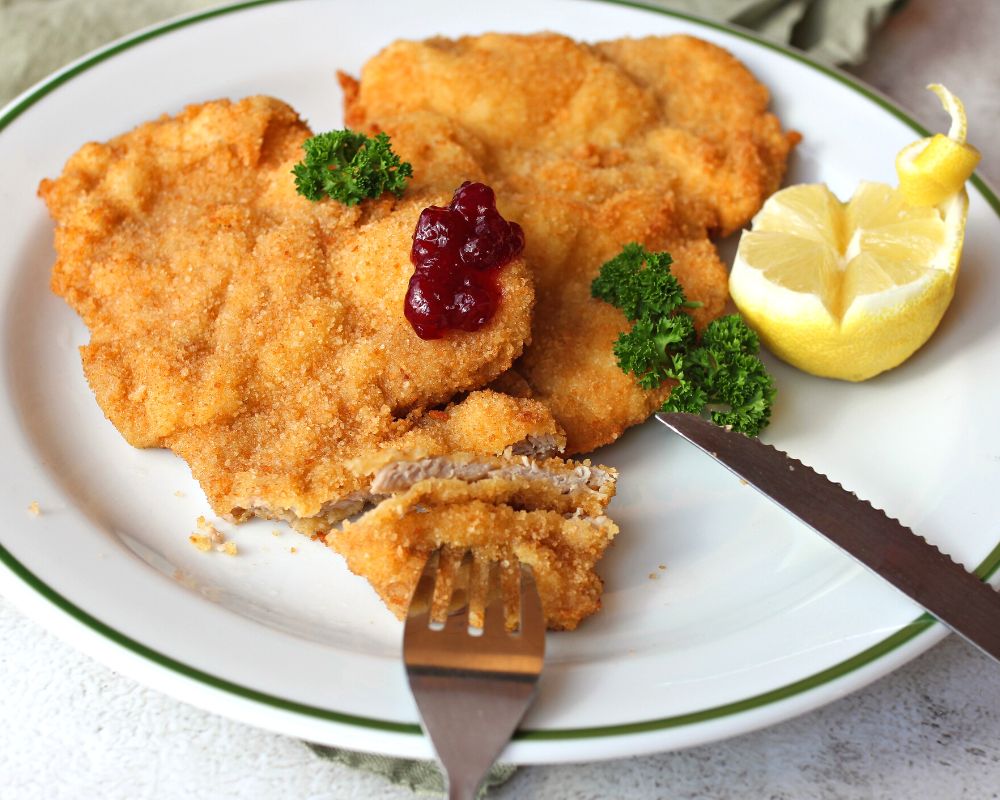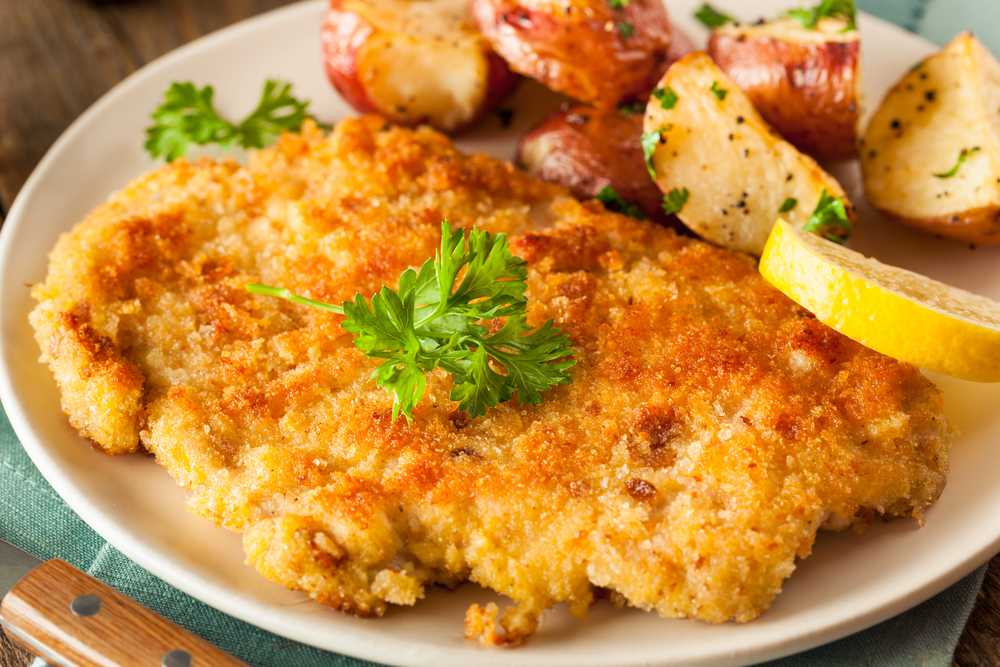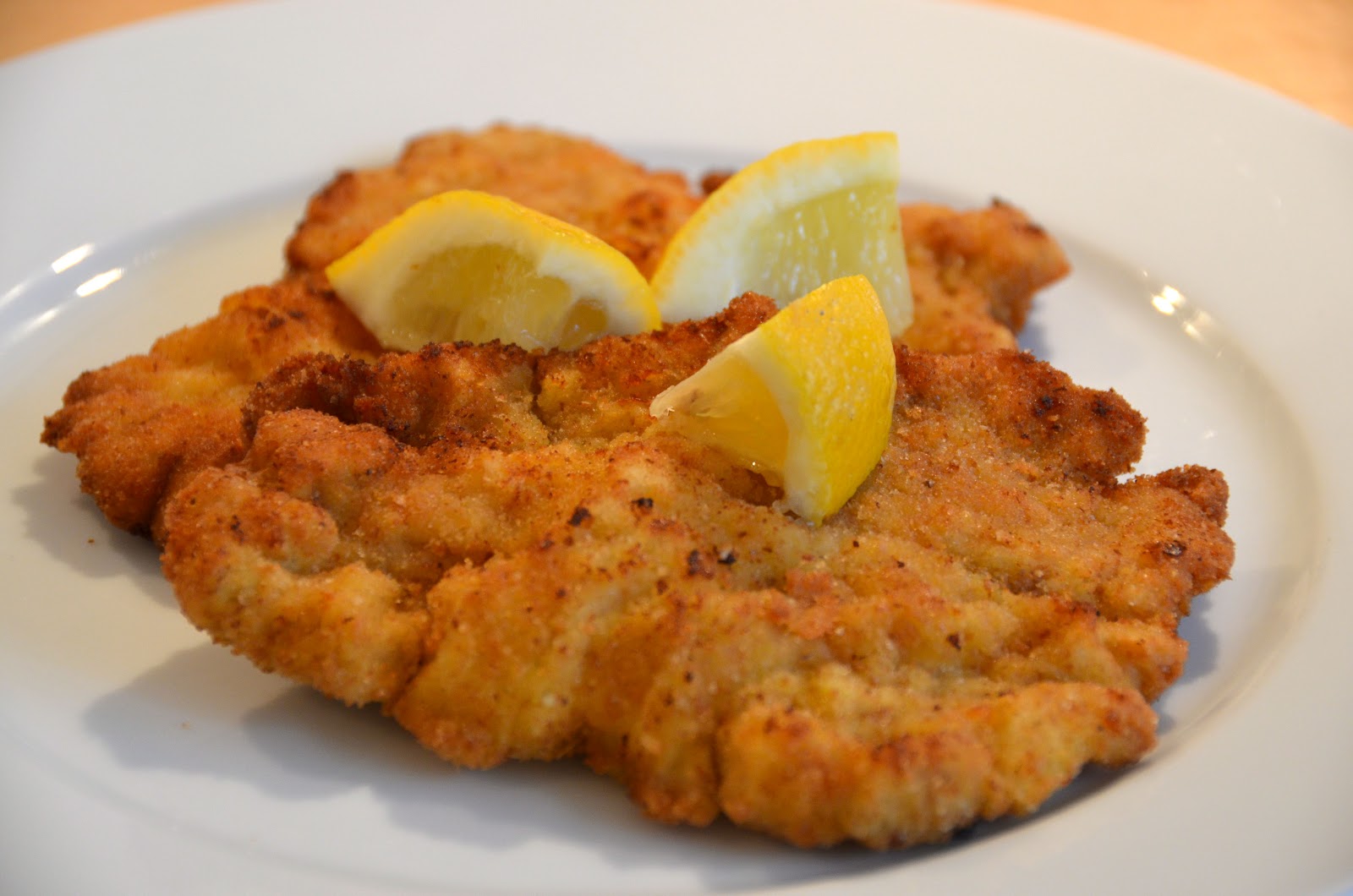Etymology and Linguistic Origins of “Wiener Schnitzel”

The term “Wiener Schnitzel,” a culinary icon synonymous with Viennese cuisine, boasts a rich history reflected in its etymology. Understanding its linguistic roots reveals a fascinating journey through time and culinary evolution, highlighting the interplay of cultural influences and linguistic shifts. The seemingly simple name is a powerful indicator of the dish’s origin and enduring popularity.
The term is a compound word, effortlessly combining two distinct elements: “Wiener” and “Schnitzel.” “Wiener,” derived from “Wien,” the German name for Vienna, directly pinpoints the dish’s geographical origin. This instantly establishes a connection to Austria’s capital city, associating the dish with its unique culinary heritage. The second component, “Schnitzel,” originates from the German verb “schneiden,” meaning “to cut.” This refers to the thin, flattened cutlet of meat that forms the basis of the dish. Thus, the name literally translates to “Viennese cutlet,” a straightforward and descriptive appellation that reflects the dish’s preparation.
The Historical Evolution of “Wiener Schnitzel”
While the precise origins of the Wiener Schnitzel remain debated among food historians, its evolution is inextricably linked to the Habsburg Empire’s culinary landscape. Early forms of breaded cutlets existed across Europe long before the Wiener Schnitzel’s emergence. However, the Viennese version, with its specific preparation and association with Vienna, solidified its unique identity. The 19th century witnessed the dish’s rise to prominence, becoming a staple in Viennese restaurants and solidifying its place in Austrian culinary culture. The term itself likely gained widespread currency during this period, as Vienna’s influence as a major European capital spread. The consistent use of the term across various cookbooks and culinary texts of the era further supports this timeline.
Regional Variations and Usage
The term “Wiener Schnitzel” is predominantly used in German-speaking countries and regions with strong ties to Austrian culinary traditions. However, variations exist, primarily reflecting differences in the type of meat used (veal is traditional, but pork or chicken are common alternatives). In some regions, subtle adjustments to the breading or cooking method might exist, leading to minor variations in taste and texture. Yet, the core concept of a thinly pounded, breaded, and pan-fried cutlet remains consistent, preserving the essence of the original Wiener Schnitzel. The term’s use extends beyond mere culinary descriptions; it often appears in menus, recipes, and even cultural references, signifying a specific culinary experience associated with Viennese heritage and sophistication.
Culinary Aspects of Wiener Schnitzel
Wiener Schnitzel, a culinary icon of Austria, transcends its simple ingredients to represent a sophisticated interplay of technique and tradition. Its seemingly straightforward preparation belies a mastery of specific methods crucial to achieving the perfect result: a crisp, golden-brown exterior encasing a tender, juicy interior. This delicate balance is the hallmark of a truly exceptional Wiener Schnitzel.
Weinersnitchel – The traditional preparation of Wiener Schnitzel centers around a specific type of veal cutlet, typically from the leg or topside. The cutlet is pounded thinly and evenly, a crucial step to ensure even cooking and a delicate texture. This process, often done with a meat mallet, tenderizes the meat and creates a larger surface area for breading. The pounded cutlet is then dredged in flour, dipped in beaten egg, and finally coated thoroughly in breadcrumbs. The type of breadcrumb is important; fine, dry breadcrumbs are preferred for optimal crispness. The schnitzel is then pan-fried in clarified butter or a blend of butter and oil at a high temperature until golden brown and cooked through. This high-heat frying is key to achieving the characteristic crispness. The final touch often involves a squeeze of lemon juice and a sprinkle of parsley.
Variations of Wiener Schnitzel
Variations on the Wiener Schnitzel exist across different culinary traditions, each reflecting local ingredients and preferences. While the core technique remains largely consistent—thinly pounded meat, breading, and high-heat frying—differences arise in the type of meat used, the breading, and accompanying sauces. For instance, some regions might use pork or chicken instead of veal, leading to a different flavor profile and texture. The type of breading can also vary, with some recipes incorporating herbs or spices into the breadcrumbs. Furthermore, different sauces and sides accompany the schnitzel in various regions, enhancing the overall culinary experience. In some areas, a simple lemon wedge is sufficient; in others, a rich mushroom sauce or a creamy tartar sauce is preferred.
Recipe for Wiener Schnitzel
This recipe aims to recreate the classic Wiener Schnitzel experience. The use of high-quality ingredients and attention to detail are crucial for optimal results.
| Ingredient | Quantity | Notes | Preparation |
|---|---|---|---|
| Veal Cutlets | 4 (about 1/4 inch thick) | Look for thin cutlets; if using thicker ones, pound them thinner. | Pound to an even thickness using a meat mallet. |
| All-Purpose Flour | 1/2 cup | Use a fine flour for a smoother coating. | Place in a shallow dish. |
| Eggs | 2 large | Lightly beaten. | Whisk in a shallow dish. |
| Breadcrumbs | 1 1/2 cups | Fine, dry breadcrumbs are ideal. | Place in a shallow dish. |
| Clarified Butter | 1/2 cup | Or a mixture of butter and oil. | Heat in a large skillet over medium-high heat. |
| Salt and Pepper | To taste | Season generously. | Season the veal cutlets before breading. |
| Lemon Wedges | 4 | For serving. | Serve alongside the schnitzel. |
| Parsley | Fresh, chopped | For garnish. | Sprinkle over the finished schnitzel. |
Instructions: Dredge each veal cutlet in flour, shaking off any excess. Dip in the beaten egg, ensuring it’s fully coated. Finally, coat thoroughly in breadcrumbs, pressing gently to adhere. Fry the schnitzel in hot clarified butter for 2-3 minutes per side, or until golden brown and cooked through. Remove from the skillet and drain on paper towels. Serve immediately with lemon wedges and fresh parsley.
Cultural Significance and Regional Variations: Weinersnitchel
Wiener Schnitzel transcends its culinary status; it’s a cultural icon deeply embedded in the Austrian identity and celebrated across numerous countries. Its popularity extends far beyond its birthplace, reflecting a fascinating interplay of culinary diffusion, adaptation, and cultural appropriation. Understanding its cultural significance requires exploring its role in various societies and how it’s perceived and consumed within different contexts.
The cultural significance of Wiener Schnitzel is multifaceted. In Austria, it’s more than just a dish; it’s a symbol of national pride, a culinary tradition passed down through generations, and a staple of everyday life and special occasions. Its presence on menus across the country, from traditional “Gasthäuser” (pubs) to upscale restaurants, underscores its enduring appeal and cultural relevance. Beyond Austria, the dish’s popularity speaks to its adaptability and the ability to integrate into diverse culinary landscapes while retaining its core identity. However, this widespread adoption also prompts discussions about authenticity and the potential dilution of the original culinary tradition.
Wiener Schnitzel in Austria: A National Treasure
Wiener Schnitzel holds a prominent place in Austrian culinary heritage. It’s frequently featured in traditional Austrian cookbooks, often passed down through families, each with their own subtle variations and secret techniques. Its presence in everyday life is undeniable; it’s a common lunchtime dish, a festive meal, and a frequent offering at “Heuriger,” traditional wine taverns. The tender, thin cutlet, expertly breaded and pan-fried to golden perfection, embodies a sense of comfort and familiarity for many Austrians. The preparation itself, a demonstration of culinary skill and precision, is often seen as a mark of culinary expertise.
Regional Variations and Adaptations
The popularity of Wiener Schnitzel has led to diverse regional interpretations. While the core elements—thinly pounded veal cutlet, breading, and shallow frying—remain consistent, variations in breading techniques, frying methods, and even the type of meat used reflect local preferences and culinary traditions.
- Vienna: The Viennese version typically utilizes veal, emphasizing a delicate, almost ethereal texture. The breading is often light and crispy, with a focus on achieving a golden-brown color without over-browning. A classic Viennese Wiener Schnitzel is served with lemon wedges and potato salad.
- Southern Germany: In Southern Germany, the use of pork cutlets is more common, leading to a richer, meatier flavor profile. The breading might be slightly thicker, resulting in a more substantial crust. They often accompany it with potato dumplings or spaetzle.
- Czech Republic: The Czech version, known as “Řízek,” often uses pork or chicken, and the breading can incorporate herbs or spices. It’s often served with bread dumplings and a creamy mushroom sauce.
- Italy: In Italy, variations exist, often incorporating local ingredients and culinary styles. The use of different types of flour in the breading, and the addition of herbs or spices, creates distinct regional variations. The cutlet might also be slightly thicker than in the traditional Austrian version.
Cultural Perceptions and Consumption
The perception and consumption of Wiener Schnitzel vary significantly across different cultures. In Austria, it’s often seen as a relatively informal dish, suitable for both casual and more formal occasions. In other countries, it may be perceived as a more sophisticated or upscale meal, often served in restaurants specializing in Central European cuisine. The manner of consumption also varies; some prefer to eat it with a knife and fork, while others may opt for a more casual approach. The side dishes, too, contribute to these cultural variations, ranging from traditional potato salads and dumplings to more modern accompaniments.
Wiener Schnitzel in Popular Culture and Media

Wiener Schnitzel, far from being confined to the culinary sphere, has made its mark on popular culture, subtly weaving its way into narratives and becoming a symbol of various themes, from comfort and nostalgia to opulence and even cultural clash. Its presence, though often understated, speaks volumes about its enduring appeal and its ability to transcend mere food to become a potent narrative device. Its depiction often reflects the cultural context in which it appears.
Wiener Schnitzel’s appearances in media are diverse, ranging from fleeting mentions to pivotal plot points. The dish’s symbolic weight varies depending on its context; sometimes it represents simple pleasures, other times, a specific cultural identity or a moment of shared experience. This versatility allows for its inclusion in a wide array of media formats.
Examples of Wiener Schnitzel in Literature and Film
The precise number of instances where Wiener Schnitzel features prominently in literature and film is difficult to quantify definitively. However, its presence, while not always central, is demonstrably present. Consider, for instance, the potential for a character in a period drama to order Wiener Schnitzel in a Viennese cafe, subtly establishing their social standing or their connection to Austrian culture. Similarly, a scene in a contemporary film might depict a family enjoying Wiener Schnitzel as a way to highlight a cherished tradition or a sense of belonging. The dish’s role is often to add a layer of authenticity, cultural context, or simply to evoke a specific atmosphere. One could imagine a scene in a romantic comedy where a character’s attempt to make a perfect Wiener Schnitzel goes hilariously wrong, serving as a catalyst for a comedic misunderstanding or a bonding experience. The potential uses are nearly limitless.
Symbolic Portrayals of Wiener Schnitzel, Weinersnitchel
In many instances, Wiener Schnitzel functions as a visual shorthand for comfort food, nostalgia, and familial gatherings. Its golden-brown crispness and tender meat evoke feelings of warmth and satisfaction, often associated with happy memories and home-cooked meals. In other contexts, however, it can represent a more refined taste, a symbol of affluence or sophistication. A character enjoying Wiener Schnitzel in a luxurious setting might suggest a certain level of wealth or cultural refinement. The symbolic meaning is fluid and heavily reliant on the narrative context.
Fictional Scene Featuring Wiener Schnitzel
[SCENE START]
INT. VIENNESE CAFE – DAY
ANNA (30s), elegant and sharp, sits across from MARK (30s), a charming but slightly clumsy American tourist. They’re halfway through a meal. Before them sits a plate of perfectly prepared Wiener Schnitzel, accompanied by a traditional potato salad.
MARK
(Mouth full)
This is…amazing. I’ve never had anything like it. Back home, we have…well, we have schnitzels, I guess, but nothing like this.
Anna smiles, taking a delicate bite of her own schnitzel.
ANNA
It’s the veal, you see. And the breading…it’s a specific technique, passed down through generations. It’s more than just food, Mark. It’s a tradition.
Mark nods thoughtfully, gazing at the remaining schnitzel. He picks up his fork, a newfound respect in his eyes.
MARK
I understand. It’s…a piece of history on my plate.
Anna leans forward, her eyes twinkling.
ANNA
Precisely. And a delicious one at that.
[SCENE END]
Economic and Social Impact of Wiener Schnitzel
Wiener Schnitzel, a seemingly simple dish, exerts a surprisingly significant impact on both the economic and social landscapes of Austria and beyond. Its influence extends from local economies reliant on its production and consumption to its role as a cornerstone of social gatherings and cultural identity. Understanding this impact reveals a deeper appreciation for the dish’s enduring appeal and its contribution to the broader cultural fabric.
The economic influence of Wiener Schnitzel is multifaceted, encompassing various sectors from agriculture to tourism. From the farmers supplying veal to the restaurants serving the finished product, numerous businesses directly benefit from its popularity. Furthermore, the dish contributes significantly to the culinary tourism industry, attracting visitors who actively seek out authentic Wiener Schnitzel experiences. This in turn boosts local economies through increased spending on accommodation, transportation, and other related services.
Economic Contributions of Wiener Schnitzel Production and Consumption
The economic impact of Wiener Schnitzel is substantial, demonstrably impacting numerous sectors within the Austrian economy and economies of countries where it’s a popular dish. Quantifying this impact precisely is challenging due to the interwoven nature of the food industry, but we can highlight key areas of contribution.
| Sector | Economic Impact | Example | Data Source (Illustrative) |
|---|---|---|---|
| Agriculture (Veal Farming) | Provides a significant market for veal production, supporting farmers and related industries. | Increased demand for veal directly translates into higher prices and greater investment in farming infrastructure. | Austrian Federal Ministry of Agriculture, Regions, and Tourism (Illustrative) |
| Food Processing and Distribution | Supports employment in meat processing plants, distribution networks, and related businesses. | Companies specializing in breadcrumb production and other ingredients experience increased demand. | Industry Associations (Illustrative) |
| Hospitality and Tourism | A key driver of tourism, attracting visitors and generating revenue for restaurants, hotels, and related businesses. | Restaurants featuring Wiener Schnitzel on their menus often see higher customer traffic and revenue. | Tourism Statistics Austria (Illustrative) |
| Retail | Increased sales of ingredients (bread crumbs, veal, etc.) and related kitchenware. | Supermarkets and specialty stores experience higher demand for products associated with Wiener Schnitzel preparation. | Retail Sales Data (Illustrative) |
Social Significance of Wiener Schnitzel Consumption
Beyond its economic significance, Wiener Schnitzel holds a prominent place in Austrian social life, acting as a symbol of national identity and a central feature in various social contexts.
Its presence at family gatherings, celebratory meals, and informal get-togethers underscores its importance in forging social bonds and maintaining cultural traditions. The sharing of Wiener Schnitzel transcends a simple meal; it becomes a shared experience that strengthens community ties and fosters a sense of belonging. Furthermore, its inclusion in traditional festivals and events further reinforces its cultural relevance and its role in preserving Austrian heritage.
For instance, imagine a traditional Austrian family celebration – a birthday, a wedding, or even a simple Sunday dinner. The presence of Wiener Schnitzel on the table isn’t merely a culinary choice; it’s a statement of tradition, family unity, and shared cultural heritage. This transcends simple consumption and becomes a powerful symbol of social cohesion and identity.
Illustrative Description of Wiener Schnitzel

The Wiener Schnitzel, a culinary icon of Austria, is more than just a dish; it’s a sensory experience. Its appeal lies not only in its rich history and cultural significance but also in its captivating visual presentation and unparalleled taste. Understanding these aspects is key to appreciating its enduring popularity.
A perfectly prepared Wiener Schnitzel is a sight to behold. Imagine a thin, delicately pounded veal cutlet, nearly translucent at the edges, boasting a golden-brown, flawlessly crisp crust. This shattering exterior contrasts beautifully with the tender, pale interior of the meat, showcasing a subtle sheen from the rendered fat. The aroma, a symphony of browned butter and sautéed herbs, wafts through the air, promising a delightful culinary journey. The edges are often slightly curled, a testament to the careful frying process, and the overall presentation is one of elegant simplicity.
Sensory Experience of Wiener Schnitzel
The sensory experience begins even before the first bite. The crisp crackle of the breading as the knife cuts through the exterior is a prelude to the explosion of flavors and textures. The initial crunch gives way to the succulence of the veal, tender and juicy, perfectly complemented by the subtle seasoning. The breading, light yet substantial, provides a textural counterpoint to the melt-in-your-mouth meat. The lingering taste is a blend of savory richness, subtle herb notes, and a hint of lemon, leaving a lasting impression on the palate. The overall culinary impact is one of satisfying indulgence, a testament to the balance of flavors and textures.
Preparation Process: A Sensory Narrative
The preparation of a Wiener Schnitzel is a process that engages all the senses. First, the rhythmic pounding of the veal, transforming a thick cutlet into a delicate, almost paper-thin sheet, creates a soft, percussive sound. The sight of the veal expanding under the mallet is equally fascinating. Next, the delicate dance of the cutlet in the hot oil, the sizzle and sputter creating a captivating soundscape, is mesmerizing. The aroma of sizzling butter and herbs intensifies as the golden-brown crust develops. Finally, the carefully plated Schnitzel, garnished with a lemon wedge, presents a visually stunning and fragrant culinary masterpiece, ready to be enjoyed.